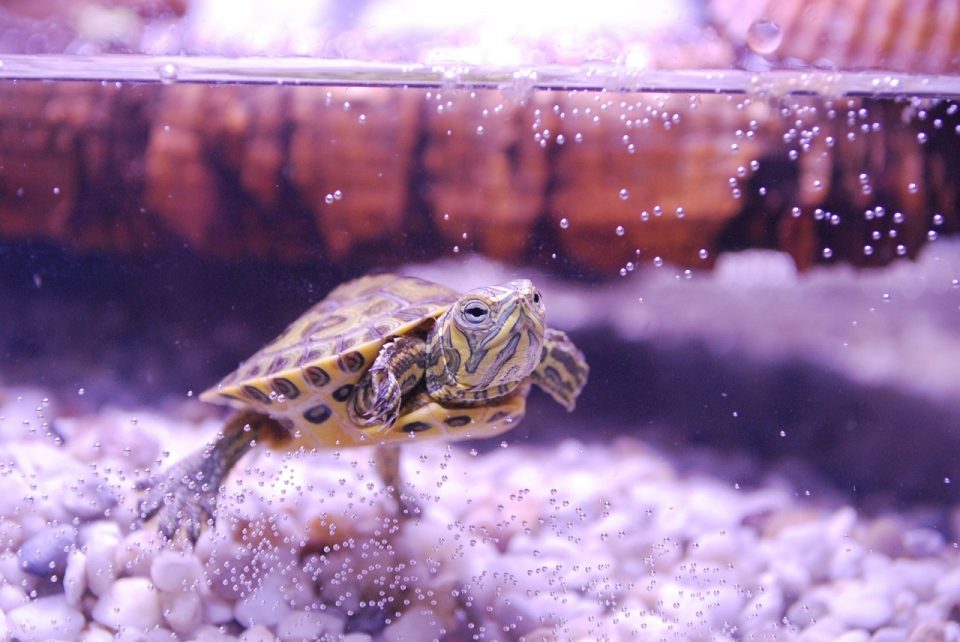Hi, my name’s Irena and I live on the island of Crete in the Mediterranean Sea with my dog Sherlock who is very hyperactive, but I love him to bits.
I also have 3 wonderful cats, Hamlet, Dimitris and Ebony. When I was a child, I had a tortoise who just turned up in our garden and never went away. He was lovely and didn’t mind being handled.
In this article I’m going to talk about turtles and the types of enclosures and tanks they should have.
In Europe turtles and tortoises are differentiated, turtles being aquatic and tortoises, land dwellers. The differentiation can often vary by country, which can make it quite confusing!
Types of Turtles
Believe it or not, there are over 300 species of turtles, although not all of them are suitable to be kept as pets.
Turtles have been around for 230 million years, even before dinosaurs inhabited the earth.
The largest turtle is the Leatherback Sea Turtle whose shell can be as long as 6.6 feet. They can weigh as much as 2,000 pounds.
The smallest turtle, the Speckled Padloper is only around 3.1 inches and weighs just 5 ounces, so is tiny.
You can certainly lift one of those in your hand, unlike the Leatherback! Here I’m going to talk about six different turtles which are suitable to keep as pets.
Red-Eared Slider
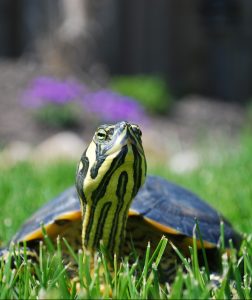 The first turtles I’m going to introduce you to are the Red-Eared Sliders which got their name because they have a red patch behind each eye.
The first turtles I’m going to introduce you to are the Red-Eared Sliders which got their name because they have a red patch behind each eye.
These turtles are very popular as pets in the US and in fact all over the world. They originate from the Gulf of Mexico and Texas. They are a lifetime commitment as they live for between 50 – 70 years.
Red-Eared Sliders can grow up to around 12 inches in diameter. Apart from the red behind their eyes they are greenish in color.
They are strong swimmers, so they need an aquarium with plenty of water and a basking area.
These turtles can be fed commercial food designed for turtles, but it is also a good idea to add fresh fruit and green vegetables. In this way you can be assured that they are getting the proper nutrition.
Most turtles hibernate and Red-Eared Sliders are no exception. They start becoming inactive from October onwards if the temperature goes below 50 degrees F.
If you live in a hot climate, they may not hibernate at all. Believe it or not, sometimes they even hibernate underneath the water.
Painted Turtle
The next turtle we’re going to look at is the Painted Turtle. It’s another very popular turtle in the US.
They get their name because their shell looks like a painting with bright and colorful green, red and yellow colors.
They are a little smaller than the Red-Eared Slider. An adult will reach 10 inches in length and they will live up to 25 years. They are aquatic and in the wild will be found near marshes and ponds.
Turtles are omnivores. The Painted Turtle can be fed commercial food, but it is good to supplement their diet with fish and dried-up chicken.
For balanced nutrition add green vegetables like spinach and collard greens..
Like Red-Eared Turtles, Painted Turtles go into hibernation when the temperature falls below 50 degrees F. Again, if the temperature is warm all year round, they won’t hibernate.
Box Turtles
The next turtles we’re going to look at are Box Turtles which are unique in that they can completely hide in their shells, much like a box.
They are not aquatic, and they don’t have completely webbed feet. They have hinged bellies which can close tightly to protect themselves from predators.
Box Turtles can grow up to 6 inches in diameter and they have a high-domed shell which is unusual in turtles.
Box Turtles are a lifetime commitment as they can live up to 80 years. You will need to make sure that you have someone to look after them if you die first.
I know it’s not a nice thing to think about, but it is something which has to be done.
Box Turtles are omnivores, so they need to be fed a variety of food. They can eat a mixture of vegetables, insects, worms and fresh fruit.
You need to put the food in a bowl on the basking area so that you keep the tank clean.
These turtles bury into the substrate in the wild when they want to hibernate.
However, if they are getting around 13 hours of daylight in captivity, they may not hibernate at all.
If you see your Box Turtles trying to burrow, you will know that they want to hibernate. Put them somewhere where the temperature is between 45 and 60 degrees F.
Wood Turtles
The next turtles we are going to talk about are Wood Turtles which got their name because their shells are brown and tan, while their legs are yellow and red.
They come from Mexico and Costa Rica although they are available as pets in the US.
There are 4 sub-species of Wood Turtle, but the most common one to be kept as a pet is the Ornate Wood Turtle. They can grow up to 9 inches in diameter and males are usually larger than females.
Wood Turtles like a meat-rich diet. You can even feed them cat food, which is very high in animal protein.
Also add some green leafy vegetables so they get a balanced meal together with fruits such as bananas and strawberries.
When it comes to hibernation, Wood Turtles are like a lot of other turtles and they will hibernate if the temperature is cold enough.
If you live in a climate which is temperate all year you will probably find that your Wood Turtles won’t hibernate.
African Aquatic Sideneck Turtles
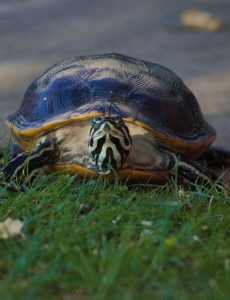 The next turtles we are going to talk about are the African Aquatic Sideneck Turtles.
The next turtles we are going to talk about are the African Aquatic Sideneck Turtles.
They are becoming very popular pets as they are more active in the day rather than the night, so they are more entertaining. In addition, they’re not an endangered species so are easy to get hold of.
Sideneck Τurtles are so called because they can’t completely hide their heads inside their shells, but instead take their heads to one side and fold them below their shells.
They can grow up to 18 inches so are quite big in comparison to the other turtles I have mentioned. They can live up to 25 years, so they are a commitment.
Sideneck Turtles are usually dark in color. Their heads are usually dark gray but can be either brown or olive in coloring, and their bellies are also dark gray with yellow colors.
These turtles don’t have completely webbed feet although they are aquatic.
They do have sharp claws so beware. However, their mouths look like they are smiling so they are considered to be a cute pet.
Sideneck Turtles are omnivores so you will need to give them a balanced diet of both animal protein and vegetables.
Don’t succumb to the fact that your turtles prefer one type of food to another.
They need a varied diet which should consist of mainly protein in the form of insects and worms. However, as they grow add more green leafy vegetables.
You can feed them a diet of commercial turtle food, but add fish, cooked chicken, snails, dandelions and collard greens to give them a completely balanced diet.
Unlike many aquatic turtles, Sidenecks don’t hibernate seasonally so make sure that the temperature is favorable to stop them from hibernating.
If you live in a cold area, make sure that you keep the heat lamp on.
Reeve’s Turtles
The last turtles we are going to look at are Reeve’s Turtles. These turtles are very popular in the US and have been widely imported from Japan and China.
They grow to around 6 inches in diameter and come in shades of tan and black. There are lines on their heads and necks.
They live to between 20 and 25 years of age and unlike most aquatic turtles they enjoy being handled.
Reeve’s Turtles eat both meat and vegetables.You can feed them a good commercial turtle food, but it is a good idea to add some extra protein in the form of chicken, fish, worms and insects.
For minerals and vitamins give them some green leafy vegetables.
These turtles start to get inactive around October and will hibernate when the temperature drops below 50 degrees F. They will sleep until the spring when the weather warms up.
How to Choose the Right Turtle Tanks
Different species of turtles require different sizes of tanks. It all depends on their size and whether they are aquatic or not.
Red-Eared Sliders are quite big at a foot in diameter so they need a tank that will hold between 30 and 50 gallons of water.
Turtles are generally dirty so make sure that the tank has a good filtration system.
The ideal temperature for Red-Eared Sliders is 75 – 80 degrees F in the water and the basking area should be 85 – 88 degrees F. Although they are aquatic, they still need to come up to relax.
Painted Turtles don’t need as large an environment as Red- Eared Sliders as they aren’t quite as big.
They too are aquatic, but they will need a basking area. The best temperature range for them is 60 – 90 degrees F. They need to have light for between 10 and 12 hours a day.
Unlike the other turtles I have mentioned, Box Turtles are land-dwelling and would be called tortoises in Britain.
They don’t need an aquatic environment to grow, but they do like to wade every now and then so provide them with a small pool.
You can set up their enclosure outside if you live somewhere with clement weather. The enclosure can be made of wood and wire rather than a tank.
The advantage of putting them outdoors is that the enclosure can be bigger than an indoor aquarium.
However, if the weather isn’t so good keep them in a glass aquarium or plastic tub indoors. Box Turtles survive the best in temperatures of 60 degrees F or more.
These turtles do well with a substrate made of something like sand, potting soil or leaves.
Spray this with water on a daily basis so that the enclosure stays humid. Box turtles don’t do well in a dry atmosphere and can suffer from dry eye or respiratory illnesses.
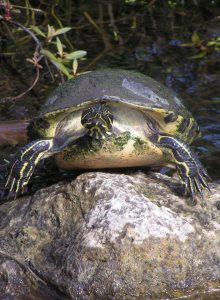 Wood turtles are semi-aquatic and can be kept outside or in. The minimum length of the enclosure should be 84 inches.
Wood turtles are semi-aquatic and can be kept outside or in. The minimum length of the enclosure should be 84 inches.
You need to put a tub of water in the enclosure so that they can swim if they want to. However, don’t make it too deep as wood turtles can drown.
Put a thick substrate on the floor of the enclosure so they can burrow, something which they love to do. If you are having an outdoor enclosure, make sure that part of it is in the shade.
African Aquatic Turtles can also be kept inside or out depending on your climate.
They need a large tank as they are aquatic, but they also need a basking area as this is essential for healthy growth.
A single turtle will need about 40 gallons of water and the level of water should be 6 – 8 inches.
Reeve’s Turtles are not very good swimmers, so they need a shallow depth of water. It should be no more than 3 times the length of your turtles.
A single baby Reeve’s Turtle would do well in a 15-gallon tank with 5 gallons of water.
What to Put in Turtle Tanks
Of course, there has to be water. Aquatic turtles need a home that is 75% water while semi-aquatic turtles should have 50%.
Land dwelling turtles need 25% water in the tank in their enclosures. Non-chlorinated water should be used.
A heat lamp is essential as turtles need one to regulate their body temperature. Put this above the basking area and ensure that the temperature remains between 80- and 85-degrees F.
Check the temperature every day. Turtles also need UVB lights which you can put on a timer so they can differentiate between day and night.
Turtles make a mess in the water so connect a filter to keep the water clean. This, however, doesn’t mean that you don’t need to clean the tank.
It should be cleaned every week. A sulfa block will also help to treat the water.
For a natural habitat, add plants. You can use either real or fake plants, but if your turtles seem inclined to eat the fake plants, swap them for real.
The advantage of live plants is that they can boost oxygen levels. However, first check to see if the plants are poisonous to turtles.
As I’ve said, all turtles need a basking surface.
You can buy these from a pet store, or you can alternatively collect rocks and make your own surface. Caves are another good addition to add to turtle tanks.
Now we’re going to take a look at my 6 choices of tanks for turtles.
Top 6 Best Turtle Tanks & Enclosures
1) TetraFauna Aquatic Turtle Deluxe Aquarium Kit
This kit contains everything you need to set up an aquarium for your turtles. It is 20 gallons in size and measures 30” L x 12” W x 12” H.
It comes with a screen top which gives plenty of ventilation for your turtles.
The filter is unique as it comes in the form of a rock with a waterfall. It works in 3 stages and there are cartridges included.
In addition, there is already a basking platform, so you don’t need to buy one. Attached to the screen top are 2 dome lamps to keep your turtles warm.
One is a 60-Watt heating bulb and the other a 13-Watt 5.0 UVB bulb. You also get some samples of RepttoMin Baby Food Floating Sticks and Aquasafe Water Conditioner.
2) Turtle Tank Aquarium by Hamiledyi
This tank will suit smaller turtles as it holds 5 gallons of water. It is kidney shaped, is open-topped and is semi-transparent so that your turtles can look out and about.
It is made from high-grade plastic and is sturdy, durable and non-toxic and has a platform for your turtles to bask on as well as a non-slip ramp leading up to it.
There is also a food trough, a swimming area and a breeding and hibernation area. It doesn’t come with a filter or heat lamp which is reflected in the very reasonable price.
3) Reptile Habitat Setup Aquarium Tank by STS Supplies
This is another tank which comes with just about everything you need for a turtle tank. It holds 10 gallons of water and measures 21.74” L x 11.99” W x 13.99” H.
It has a screen lid which lets in lots of ventilation. There is a basking area with a ramp and an LED lamp to keep your turtles warm.
The water is cleaned by a Tetra Whisper 2 – 10i filter. All you have to do is put in a few plants and buy some food and you’re ready to introduce your turtles to their new environment.
4) PETALOO Turtle Tank
This turtle tank measures 15.7 L x 9.1” W x 5.1” H. It is strong and sturdy and can take up to 350 pounds in weight, so you know that your turtles are going to be safe and secure.
It is made of plastic and is semi transparent so your turtles can see out.
There is a breeding and hibernation area, a diving and swimming area and a basking platform which has a non-slip ramp.
The open top makes it easy to clean and to get to your turtles. You have to buy the filter and heat lamp separately.
5) ZooMed Tortoise House
If you have land-dwelling turtles, otherwise known as tortoises, this enclosure will be great. It’s 36” L x 24” W x 12” H so your turtles will have plenty of room to move about.
It is divided into 2 sections. One is the sleeping area which has a weatherproof lid so your tortoises can have some alone time and hide away from the sun if the enclosure is outside.
You can keep it either inside or out or move between the two according to the weather. The other section has a wired roof which can be left up.
There is room in there for a bowl of water if your turtles want to wade.
6) Creation Core Deluxe Turtle Lagoon
This is something a little different to an aquarium. It is designed with 5 different areas for your turtles to enjoy.
There is a docking ramp area which has a non-slip strip attached to aid climbing. The ramp leads to a basking area and there is also a feeding trough, a tunnel and a swimming area.
It is made for small turtles as it is 9.8” L x 5.5” W x 3.9” H. The material used to make it is non-toxic plastic which is durable and sturdy.
The surface is gentle and smooth which is good for the feet of your turtles.
Final Thoughts: Best Turtle Tanks & Enclosures
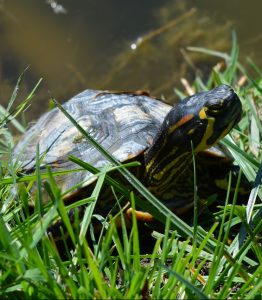 I hope you’ve enjoyed reading about turtles and have found it helpful. Perhaps you will choose one of the aquariums or enclosures I’ve chosen for your new pet.
I hope you’ve enjoyed reading about turtles and have found it helpful. Perhaps you will choose one of the aquariums or enclosures I’ve chosen for your new pet.
The starter kits which come with filters and heat lamps are a good idea if you’re getting your first turtles as everything is ready for you to get started easily.
If you get a land-dwelling turtle you are best getting an enclosure as they don’t need too much water and it’s a nice idea to put them outside on a sunny day.
We even let our tortoise roam in the garden; supervised of course. It’s a good idea to give them more space.
Whether you get an aquatic turtle, one that is semi-aquatic or a land-dwelling turtle, there is a tank or enclosure out there which will suit you.
